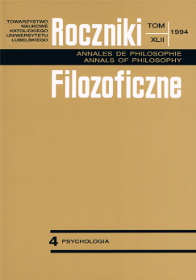The Development of Religiousness in the Child (An Outline of Psychological Problems)
Abstract
The child may surprisingly early enter a vivid and dynamic relation with God. Religiousness as a psychic ground of that relation, along with its parameters, is developing gradually under the influence of its specific factors.
In the pre-religious period, aged ca 8 to ca 15 months, viewed against the background of typically human competencies, such as communicating, there appear quasi-religious behaviors of the type of uttering religious words, concentrating on religious symbols and joining the family prayer. In the first period of religiousness, aged 2 and 3 yrs, in view of the forming of the symbolic function and social competence, there appear some tendencies of rudimentary awareness, feelings, ties and religious practices. In the period of the so-called “magic” religiousness, from ca 3.5 to 6.5 yrs, viewed against the background of a more and more symbolic, intellectualized and comprehensive grasping of reality and various ways of transcending it, the child reveals basically complete religiousness with all its parameters. In the period of the so-called “authoritarian- legal” from ca 7 to ca 11 yrs, viewed against the background of concrete logical operations, systems of grasping and organizing one’s own reality and accommodating the outcome of culture, the child reveals “rational” religiousness, that is religiousness governed by principles. Behind the latter there is a personal authority or law which is being realized in the most valuable form in the nonfamily groups and opened to a new way of existence.
Copyright (c) 1994 Roczniki Filozoficzne

This work is licensed under a Creative Commons Attribution-NonCommercial-NoDerivatives 4.0 International License.





